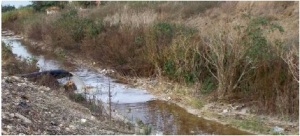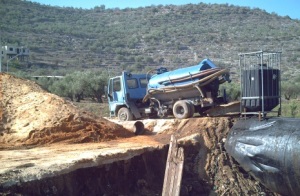
FoEME’s Good Water Neighbors project (GWN) launched one decade ago to raise awareness of the water problems shared by Jordanians, Palestinians, and Israelis.Over the last months, FoEME staff reached out to stakeholders, decision makers and funding bodies to identify the priority projects needing advancement in those communities. This consultation resulted in the development of Priority Initiatives, a document designed as a roadmap to guide the efforts of stakeholders through cross-border project activities, which was released on the Good Water Neighbors conference that took place in September in Jericho. Here, we focus on a cooperation initiative that seeks to address shared industrial wastewater pollution issues.

Similar to many neighboring communities on opposite sides of the Green Line, the Emek Hefer Regional Council and the District of Tulkarem share an important part of their water resources. Both communities are located over the western basin of the Mountain Aquifer, a key source of drinking water for both Israelis and Palestinians. The Alexander stream and its tributaries, the Zomer stream and the Teen/Teenim stream, originate eastward in the West Bank near the city of Nablus, and then flow through the Tulkarem District and across the Green Line into the Emek Hefer Regional Council. In Emek Hefer all the tributaries meet and flow westward to the Mediterranean Sea.
These streams face a deep environmental degradation, whose main cause is sewage pollution originating from the West Bank, both from domestic and industrial sources. Today, most of the sewage from the Greater Tulkarem area is channeled to the Yad Hanna waste water treatment plant (WWTP), adjacent to the Separation Barrier, on the Israeli side in Emek Hefer. But the Yad Hanna WWTP is failing to cope with the growing quantities and problematic composition of mixed industrial and domestic sewage that reaches the plant. An upgrade of the plant is required, both for coping with the challenging composition of sewage and its quantity and for meeting the new stringent Inbar Standards for sewage treatment and stream flow in Israel. Meanwhile, treatment of domestic sewage is on its way in the Palestinian side: by the end of 2012, the West Nablus WWTP will be ready to receive domestic sewage from West Nablus and progressively from the Greater Tulkarem area.

The issue of industrial sewage is trickier: the Palestinian Water Authority is advancing projects to enable collection of industrial sewage, although the best available solution has not been identified yet, both in terms of environment and finance. The industrial sewage mostly results from Palestinian stone cutting and sesame and olive mill industries in the area, which causes high levels of pollution when channeled, untreated into the natural streams. Each year between October and December, the 26 olive mills of the area discharge into nearby streams what is locally known as “akar” or ”zebra”: the wastewater of the olive oil production process, which contains a high organic load and has a toxic effect on all life forms in the streams. Frequent waste dumping from sesame industry into stream waters contribute drastically to the rise in its salinity. Finally, the stone cutting industry produces slurry: a fluid mixture consisting of lime powder and water that is also dumped into the streams. This dense wastewater cannot be treated in an intensive WWTP. Therefore, in order to protect the streams and the groundwater, there is an acute need to implement an “at source” approach to all these forms of industrial wastewater, preventing all discharge into the natural environment. Miscommunication and lack of coordination between the two sides leads to greater mistrust about pollution control. The situation is pushing Israel to develop its own “end of pipe” solutions, in the Israeli side, without coordination with the “at source” Palestinian investments: leading to double investment and smaller chances of success.
Hence, FoEME has put forth a project proposal with the neighbor communities of Emek Hefer and Tulkarem, seeking to advance pragmatic cooperation and coordination of an integrated solution for industrial wastewater pollution in the Zomer/Alexander/Teen basin. Using GIS, FoEME will compile information on sources of industrial wastewater pollution in the basin to facilitate information flow. Specific efforts will be targeted on the Palestinian side, to promote “at source” treatment of the industrial wastewater and implement an integrated plan that includes economic incentives, regulatory clarification and enforcement against all illegal wastewater disposals. In order to balance the new costs imposed on impacted industries, FoEME will work with the Palestinian Water Authority and economic experts to examine the economic potential of an ISO Certification and/or market demand that could turn current waste products into commodities.
Cross border cooperation demands dialogue. FoEME actively supports cross border coordination at the municipal and residential level between upstream and downstream communities, and will initiate and coordinate cross border field visits for relevant professionals, media and decision makers in order to avoid unilateral solutions. In addition, FoEME will seek to clarify jurisdictional issues between various Palestinian Ministries and enforcement agencies, as well as with the Israeli Civil Administration where dumping takes place in Area C, to deal with illegal dumping of sewage. Addressing this cross border pollution issue within the frame of the Good Water Neighbor project will lead to improved water quality of the Zomer/ Alexander/Teen Streams and the Mountain Aquifer, water resources that are shared by both sides.
This post has been written by FoEME intern Amélie Joseph. Amélie holds a MA in agronomy and environment and is working with FoEME on water-related issues in agriculture, in the Tel Aviv office.